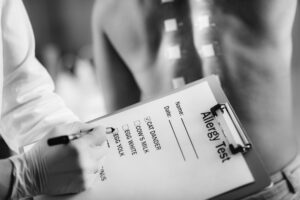Did you know that lumbar radiculopathy affects around 3 to 5% of the US population? Its prevalence increases with age and often affects men in their 40s and women in their 50s and 60s. This can cause pain, numbness, and stiffness in the back. If its symptoms are not managed on time, it can lead to severe complications. Learn about lumbar radiculopathy symptoms and management in this article. Visit the best Pain Management Clinic in Brooklyn at Doral Health & Wellness or log on to www.doralhw.org. to schedule an appointment with us.
What is lumbar radiculopathy?
Lumbar radiculopathy is a disorder that occurs when one of your nerve roots from the spine gets compressed or irritated. It causes pain that travels down the back of the thigh and into the leg. Nerve root compression at levels L1-S4 in the spine is the root cause of this condition.
Symptoms
- Tingling
- Numbness
- Shooting pain,
- Radiating discomfort
Symptoms of nerve root pathology
- Anesthesia
- Paresthesia
- Hypoesthesia
- Motor loss
- Pain
As a single symptom, radicular pain and nerve root pain might come from one or more spinal nerves. The L1-S4 spinal nerve roots are affected by lumbar sacral radiculopathy.
The most common places for radiculopathy to happen are in the lower back (lumbar-sacral radiculopathy) and neck (neck radiculopathy).
The middle of the spine is where it’s less common to find it (thoracic radiculopathy).
Lumbosacral radiculopathy is a very common condition that causes a lot of people to go to the doctor every year.
When there are no clinical red flag signs, cautious management is the best first option because the vast majority of cases are benign and will resolve on their own. Imaging tests, electromyography, and nerve conduction studies can help diagnose symptoms that don’t go away.
‘Radial pain’ or ‘nerve root pain’ is not the same thing as ‘radiculopathy.” When there is pain, there is usually radiculopathy; when there is no pain, there is usually neither.
The most common causes of lumbosacral radiculopathy are intervertebral disc disease and degenerative spine disease.
90% of radiculopathy is caused by a herniated disc that compresses the nerve roots.
Types of tumors that cause lumbar pain
- Congenital defects or degenerative alterations may cause lumbar spinal stenosis. A condition known as lumbar stenosis can be described as the narrowing of the spinal canal and the compression of the nerves that results from the causes discussed above.
- The abnormal curvature of the spine in people with scoliosis can compress the nerves on the affected side.
- Osteomyelitis, for example, is an example of an underlying disease.
- The intervertebral foramen pinches the nerve, which is the primary issue.
Management
Lumbar radiculopathy management depends on its type and severity of the symptoms. Usually, conservative treatment is the first line of defense, which includes:
- Over-the-counter (OTC) medications are used to manage acute pain symptoms, including NSAIDs, acetaminophen, and, in severe cases, opiates are prescribed. Typically, radicular symptoms are treated with neuroleptic agents. Systemic steroids are also prescribed for acute low back pain, although very limited evidence is available for their effectiveness. Nonpharmacologic interventions are also prescribed.
- Physical therapy, acupuncture, chiropractic manipulation, and traction are all commonly used in the treatment of lumbosacral radiculopathy. Still, the data supporting the use of these treatments is not conclusive.
- Interventional techniques like epidural steroid injections and percutaneous disc decompression are commonly used. In refractory cases, surgical decompression and spinal fusion can be performed.
Conservative treatment is used for the first 6 to 8 weeks. If it doesn’t make any improvement in the patient’s symptoms, then surgery is recommended. This is because the majority of patients can experience improvement with conservative treatment within 6 weeks to 3 months.
Surgical intervention for lumbar radiculopathy is called a discectomy, and this focuses on the removal of the disc herniation (damaged part of the disc). Spinal fusion is another option, where the damaged part of the joint is removed and the other two joints are fused together. Next to simple discectomy and spinal fusion, 3 other surgical treatments that also used for patients with disc herniation:
1) chemonucleolysis
2) percutaneous discectomy
3) microdiscectomy
Around 90% of all patients who have had surgery for lumbar disc herniation underwent discectomy alone, although recently spinal fusion procedures have significantly increased. It’s rare for people to experience any complications after surgical procedures.
Exercise and Exercise Programs
For acute pain relief, exercises are used, along with proper treatment management. However, less evidence was found for manipulations when it comes to the chronic phase. Because the pain that occurs from narrowing of the intervertebral foramen, normal traction of the lower spine will also relieve the pain. Besides relieving the pain, the patient also needs muscle training and, more specifically, stabilization. For that:
- Pilates exercises are used not only to provide stabilization but also for body awareness.
- The McKenzie exercise is a lower back pain-specific exercise.
- Stretching, modalities, conditioning exercises, ergonomic programs, and pain relief are part of the Physical Therapy exercise programs.
- A rehabilitation program includes postural training, muscle reactivation, correction of tightness, improved flexibility and strength, minimizing deficits, and subsequent progression to functional exercises.
Proper exercise is the key to low back pain treatment protocols. Spinal manipulation for symptom reduction shows some evidence of effectiveness in the acute phase. Only a small amount of evidence supporting interventions was identified in the case of persistent lumbar radiculopathy. In this case, since the intervertebral foramen is narrowed, regular traction of the lower spine will help ease the pain.
Along with pain relief, the patient requires muscle strengthening and more targeted stabilization. For that, you can do Pilates, which not only strengthens your core, but you also develop your awareness of your body. The McKenzie exercise is well-known for relieving lower back discomfort.
The treatment’s primary purpose is to alleviate discomfort. The first step to start an exercise regimen is to teach the patient how to become more conscious of their body (back to school). Exercise, conditioning, and an ergonomic program can all be part of physical therapy. In order to achieve a full recovery, a patient must first undergo postural training, muscle reactivation, flexibility, and strength correction, and then continue functional training. In many cases, the first line of treatment is exercise therapy.
If you’re ready to take the next step in managing your pain, we recommend consulting with our healthcare provider to explore the right treatments or therapies for you. Always listen to your body and adjust your daily routine to prioritize your well-being. Visit Doral Health & Wellness Pain Relief Department in Brooklyn, to get professional help and guidance on how to manage your problem. Call us on + 1-718-367-2555 to get a consultation. If you need help learning coping methods, register your information and make direct contact with our doctors at https://yuz88hfiyh7.typeform.com/Doralintake. Log on to www.doralhw.org. Or visit us at 1797 Pitkin Avenue, Brooklyn, NY 11212.






